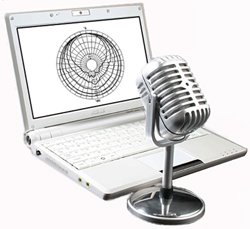
Equivalent Noise-Level
The equivalent noise-level (also known as the microphone¹s self-noise) indicates the sound pressure level that will create the same voltage as the self-noise from the microphone will produce.
A low noise-level is especially desirable when working with low sound pressure levels, so the sound will not “drown” in noise from the microphone itself.
The self-noise also dictates the lower limitation in the microphone’s dynamic range.
There are two typical standards:
1. The dB(A) scale will weight the SPL according to the ear’s sensitivity, especially filtering out low frequency noise. Good results (very low noise) in this scale are usually below 15 dB(A).
2. The CCIR 468-1 scale uses a different weighting, so in this scale, good results are below 25 to 30 dB.
EXAMPLE:
Type 4041-S Omnidirectional Solid State Microphone
Equivalent noise level A-weighted: Max. 7 dB(A) re. 20μPa
Equivalent noise level CCIR 468-1: Max. 19 dB
Sensitivity
Sensitivity expresses the microphone¹s ability to convert acoustic pressure to electric voltage. The sensitivity states what voltage a microphone will produce at a certain sound pressure level.
A microphone with high sensitivity will give a high voltage output and will therefore not need as much amplification (gain) as a model with lower sensitivity.
In applications with low sound pressure levels, a microphone with a high sensitivity is required in order to keep the amplification noise low.
According to the IEC 268-4 norm, the sensitivity is measured in mV per Pascal at 1 kHz (measuring microphones at 250 Hz).
As an alternative, the sensitivity can be submitted according to the American tradition, which states the sensitivity in dB, relatively to 1V/Pa, which will give a negative value.
A serious microphone manufacturer will also state tolerances in sensitivity, according to production differences (such tolerances would normally be in the region of 2 dB.)
EXAMPLE:
DPA Type 3530 A-B Stereo Kit
Sensitivity: Nominally 10mV/Pa; -40 dB re. 1V/Pa unloaded (at 250 Hz); Max difference 1 dB
SPL Handling Capability
In many recording situations, it is essential to know the maximum Sound Pressure Level (SPL) the microphone can handle.
Please note that, in most music recording, maximum peak SPL easily supersede the RMS value by more than 20 dB. The RMS value indicates an average SPL and will not show the true SPL peaks.
It is important to know:
1. The SPL where a certain Total Harmonic Distortion (THD) occurs.
2. The SPL where the signal from the microphone will clip, that is the waveforms will become squares. This is the term: Max. SPL and it refers to peak values in SPL.
A commonly used level of THD is 0.5 percent (1 percent is also often seen), which is the point where the distortion can be measured, but not heard.
Ensure that the THD specification is measured for the complete microphone (capsule + preamplifier), as many manufacturers only specify THD measured on the preamplifier, which distorts much less than the capsule.
The distortion of a circular diaphragm will double with a 6 dB increase of the input level, so other levels of THD can be calculated by using this factor.
EXAMPLE:
Type 4004 Hi-SPL Omnidirectional Microphone, 130 V
Maximum sound pressure level: 168 dB SPL peak
Total harmonic distortion: 142 dB SPL peak (<0.5% THD), 148 dB SPL peak (<1% THD)
Microphone specifications do not tell the whole story about a microphone’s quality and are no substitute for the sonic experience.
Although microphone specifications may not be fully comparable between manufacturers, when properly evaluated they do provide useful objectivity and will help in the search for the optimal microphone.
